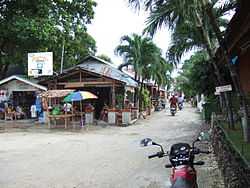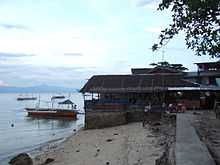Moalboal, Cebu
| Moalboal | |
|---|---|
| Municipality | |
 | |
 Map of Cebu with Moalboal highlighted | |
.svg.png) Moalboal Location within the Philippines | |
| Coordinates: 9°57′N 123°24′E / 9.95°N 123.4°ECoordinates: 9°57′N 123°24′E / 9.95°N 123.4°E | |
| Country | Philippines |
| Region | Central Visayas (Region VII) |
| Province | Cebu |
| District | 2nd district of Cebu |
| Founded | 6 February 1852 |
| Barangay | 15 (see § Barangays) |
| Government[1] | |
| • Type | Sangguniang Bayan |
| • Mayor | Inocentes Cabaron (1‑Cebu) |
| • Vice mayor | Nelson Abenido |
| • Town Council |
Members
|
| Area[2] | |
| • Total | 124.86 km2 (48.21 sq mi) |
| Population (2010)[3] | |
| • Total | 27,676 |
| • Density | 220/km2 (570/sq mi) |
| Demonym | Moalboalanon |
| Time zone | PHT (UTC+8) |
| ZIP code | 6032 |
| IDD : | +63 (0)32 |
| Income class | 4th class |
| PSGC | 072233000 |
| Website |
www |
Moalboal is a fourth income class municipality in the province of Cebu, Philippines. According to the 2010 census, it has a population of 27,676.[3]
Extending as a peninsula on the southwestern tip of Cebu, Moalboal is bordered to the west by the Tañon Strait. From the western shoreline, Negros Island can be seen. Moalboal is located 89 kilometres (55 mi) from Cebu City, about 2½ hours by bus.
Moalboal is between the towns of Alcantara and Badian. From the tulay, an unfinished bridge located in Moalboal's town proper, Badian Island can be clearly seen, as well as the popular tourist attraction, Pescador Island.
Barangays
Moalboal comprises 15 barangays:[2]
- Agbalanga
- Bala
- Balabagon
- Basdiot
- Batadbatad
- Bugho
- Buguil
- Busay
- Lanao
- Poblacion East
- Poblacion West
- Saavedra
- Tomonoy
- Tuble
- Tunga
Demographics
| Population census of Moalboal | ||
|---|---|---|
| Year | Pop. | ±% p.a. |
| 1990 | 20,041 | — |
| 1995 | 22,021 | +1.78% |
| 2000 | 23,402 | +1.31% |
| 2007 | 27,398 | +2.20% |
| 2010 | 27,676 | +0.37% |
| Source: National Statistics Office[3][4] | ||
Though the majority of the people in Moalboal are Cebuanos, a few members of cultural minorities have found their way there. Bajaus who are similar to Muslim nomads, are often seen in the streets, especially during the holiday season, as some of them make their living by begging. There is no evidence though that the badjaos have taken up permanent residence in the town.
Economy
Industry and trade
Moalboal is a peninsula and therefore is a town almost entirely surrounded by water. Majority of the people who live in the flat lands engage in fishing as their main mode of livelihood. Those who live in the mountain regions, like Agbalanga and Bala, live through farming.
The common mode of transportation is by motorcycles with side cars, known locally as pedicabs or, depending on the distance, tricycles with side cars, called trisikads.
Tourism


Since the 1970s, Moalboal has developed a tourism industry based on recreational diving and beaches. Panagsama Beach, which was blown away by a typhoon in 1984, is where most resorts and restaurants are established. Further north on the peninsula, in brgy Saavedra, is White Beach (Bas Dako in Visayan), a 2 kilometres (1.2 mi) beach which still has sand. This beach used to be quieter and mostly frequented by locals, and has only recently developed a tourist trade.
In Moalboal most tourists stay at either Panagsama Beach (Basdiot) or White beach (Basdako), known for its beautiful sandy beach and crystal clear water. There is plenty of accommodation near either beach, although Panagsama has the most bars and restaurants.
Since the resorts in the area cater mostly to divers, entertainment is laid back and there are no night clubs. Recreational diving is the main tourist activity in Moalboal, and is considered very good, even according to Philippine standards. The reefs along the west coast of the Copton Peninsula are home to a great variety of marine life. Pescador Island, about 3 kilometres (1.9 mi) off the coast, is the most popular dive spot. The structure of the reef the follows the entire coast line has made the place ideal for scuba-diving, snorkeling and freediving. Divers can enjoy easy access to the reef since the drop off is shallow and close to shore but drops down to more than 40 metres (130 ft). Big turtles can sometimes be seen very close to the shore line.
Other popular tourist attractions such as waterfalls, caves and canyons are found within 20 kilometres (12 mi) of Moalboal.
Fiesta
The annual feast of Moalboal is held on the 15th and 16th day of May. Moalboal is known also for its "Kagasangan Festival" translated "Corals Feast" in which they perform tribal dances and music.
Also barangays and subdivisions have certain fiestas:
- Agbalanga - September 29
- Balabagon - April 5
- Basdiot - April 27
- Bugho - January 28
- Poblacion East:
- Poblacion West: Dao - May 3 Pook - June 4
- Saavedra - October 15
- Tomonoy - December 8
- Tuble - January 21
- Tunga - September 17
References
- ↑ "Municipalities". Quezon City, Philippines: Department of the Interior and Local Government. Retrieved 8 April 2013.
- ↑ 2.0 2.1 "Province: Cebu". PSGC Interactive. Makati City, Philippines: National Statistical Coordination Board. Retrieved 8 April 2013.
- ↑ 3.0 3.1 3.2 "Total Population by Province, City, Municipality and Barangay: as of May 1, 2010" (PDF). 2010 Census of Population and Housing. National Statistics Office. Retrieved 1 April 2013.
- ↑ "Population and Annual Growth Rates by Province, City and Municipality: Central Visayas: 1995, 2000 and 2007" (PDF). National Statistics Office. Archived from the original (PDF) on 24 June 2011.
External links
| Wikimedia Commons has media related to Moalboal. |
 |
Alcantara |  | ||
| Tañon Strait | |
Argao | ||
| ||||
| | ||||
| Badian |
| ||||||||||||||||||